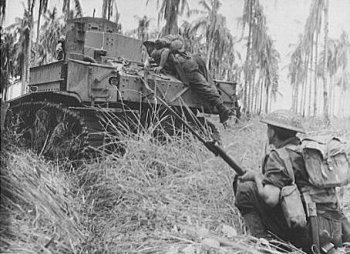![]() The Pacific War Online Encyclopedia
The Pacific War Online Encyclopedia
|
| Previous: Buena Vista | Table of Contents | Next: Bungaree, Australian Minelayer |

Library of
Congress. Via Wikipedia.org
Buna (148.401E
8.668S), on the northeast coast of New
Guinea, was a small village with a tiny anchorage and grass
airstrip in
1941.
The war would probably have passed it by, had the Japanese not gotten faulty intelligence
that there was a road from Buna across the Owen Stanley Mountains
to Port Moresby. 15 Independent Engineer Regiment
and 1 Battalion,
144
Regiment,
along with other supporting elements (totaling 1900 troops and
1200 native
laborers from Rabaul) landed
on 22 July 1942
after Allied aircraft set
one of
their transports afire.
Most of the remainder of South Seas Detachment
(Horii) came ashore on
18
August. The road
turned out to be a primitive jungle
track, the Kokoda Trail,
but the Japanese made use of it anyway, managing to push to with a
few
miles of Port Moresby before their offensive was called off
because of
the need to
divert resources to Guadalcanal.
The Oro District, in which Buna is located, is
inhabited by the
Orokaiva, a warlike culture whose former practice of
ritual cannibalism in connection with genocidal tribal warfare is
well-documented. Although some of the Orokaiva had converted
to
Christianity by 1942, many others remained extremely hostile to
Europeans, and they initially cooperated with the Japanese by
providing laborers and scouts and by turning
in escaping Allied
civilians and soldiers. In one notorious incident, Orokaiva
warriors
captured a group of nine civilians fleeing from Sangara (148.100E
8.823S),
mistreated
them, then turned them over to the Japanese, who beheaded them. The youngest
victim
was a six-year-old boy.
Later, as a result of Japanese brutality towards
native women, the Orokaiva
turned
against the Japanese.
Under pressure from Australian infantry, the Japanese retreat down the Kokoda Trail turned into a rout in which their commander was drowned while attempting to reach his troops along the coast by canoe. However, the terrain inland of Buna was ideal for defense, consisting mostly of swamps or dense undergrowth that was nearly impassable except on the few trails approaching the coastal villages. The Japanese engineers at Buna had built some of the most impressive jungle fortifications in the Pacific to cover these approaches, and the survivors of the Kokoda debacle, reinforced by newly landed elements of 5 Yokosuka SNLF, were able to rally behind the defenses.
Both sides now raced to build up their forces. On 16
November a group of four coastal craft carrying General Edwin Harding,
ammunition, and other supplies
was attacked by 18 A6M "Zeroes",
which killed 24 men and
destroyed most of the supplies. Harding was forced to swim to
shore. The next night a group of 700 replacements for 144
Regiment were landed by five destroyers northwest of
Buna, and the night after that a battalion from 229
Regiment were landed by three destroyers at Buna.
Meanwhile the Americans had marched two regiments of 32 Division
up the coast from the southeast, and another American force had
made
the grueling trip along the Jaure Trail, which was located
southeast of
the Kokoda Trail.
On 19 November 1942, the Americans began their attack on Buna, having vastly underestimated the opposition. The infantry had no artillery or tank support, and no progress was made until 30 November. The Japanese bunkers could not be bypassed and were all but impervious to infantry small arms and mortars. A bunker could be reduced only by pinning down its occupants with heavy fire so that an infantryman could approach closely enough to put a grenade through the firing slits. Most soldiers only tried this once.
The Japanese continued their reinforcement effort, bringing in elements of 21 Independent Mixed Brigade (Yamagata) in the face of strong air opposition and landing 500 troops northwest of Buna on 2 December. The Allied attack nearly ground to a halt again on 5 December. However, a few American troops reached the north shore east of Buna on the 6th, and the Japanese suffered heavy casualties in an unsuccessful counterattack. Buna village finally fell on 14 December.
The Japanese were well dug in around Buna Government Station, but they were cut off and slowly starving. Some resorted to cannibalism. After Allied reinforcements of tanks and artillery finally arrived, the Japanese strong points began to be reduced one by one. Elements of 163 Regiment began to relieve some of the exhausted Australians at Sanananda on 2 January 1943. Buna Station was stormed the same day and the remaining strongpoints were mopped up by 22 January.
MacArthur
has been criticized for pressing the American and Australian
divisions involved to attack
without proper support from tanks
or heavy weapons. At one point, he sent Eichelberger to
relieve
a division
commander with the instructions: “Go in there Bob, and take
Buna,
or
don’t come back alive!” — colorful, dramatic, and in violation of
the
Articles
of War and all military sense. It was not MacArthur’s finest hour.
Allied casualties during the campaign were 600 Americans and over
2000
Australians.
The Allies might never have been victorious at Buna but for the fact that they captured the real prize of the campaign on 20 November: the Dobodura plain. Dobodura (148.365E 8.765S) was a large area of unforested firm ground in the middle of the jungle, most likely a fossil river bed, that was suitable for rapid development of airfields. Reinforcements and supplies could be flown in and wounded taken out. Dobodura would eventually become a major Allied airfield complex.
References
"The
Story of Rubber" (2000; accessed 2011-12-4)
The Pacific War Online Encyclopedia © 2007-2008, 2010-2011 by Kent G. Budge. Index